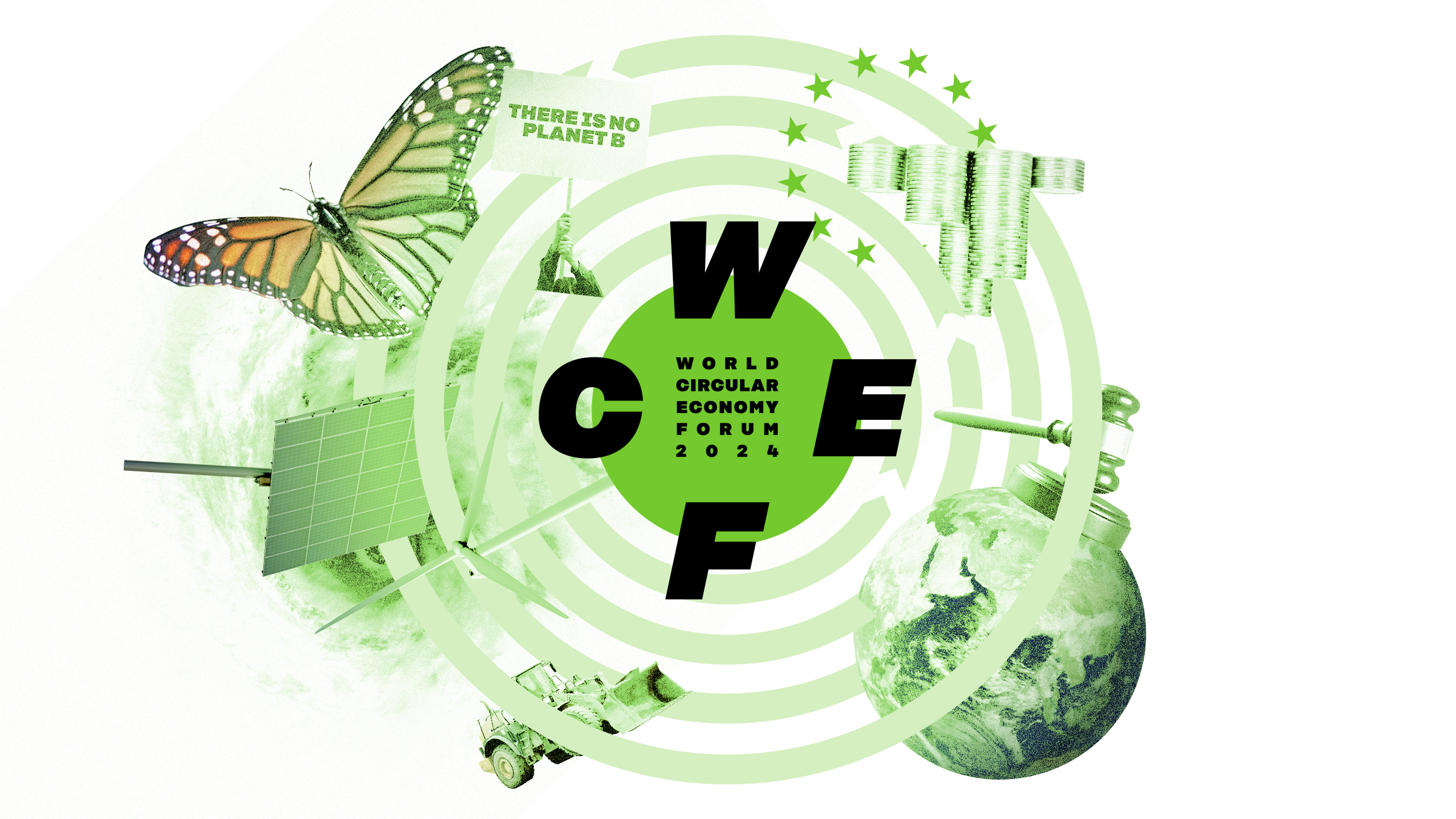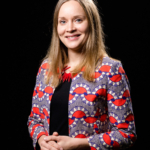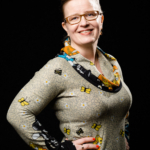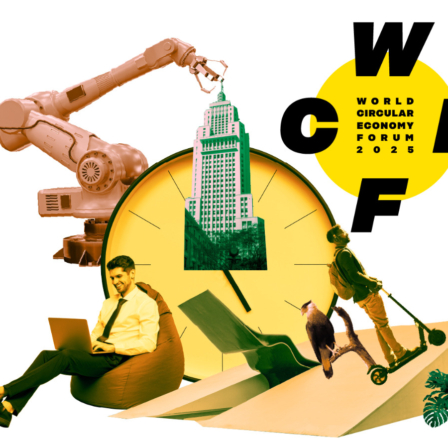What is a futures simulation?
Futures simulations (also known as social simulations) are experiential foresight methods in which participants imagine and experience a future scenario. Futures simulations can range from hands-on spatial or bodily experiences to journaling – and everything in between.
What was the WCEF2024 futures simulation about?
During the simulation, participants experienced one possible future: a national circular lifestyle experiment in 2027.
Participants were prompted to imagine a future where 100 families and individuals have been invited to participate in a one-year government-led experiment. During the experiment, participants reduced personal possessions to 100 items per person with the aim of living a more service-based lifestyle.
You can explore the scenario and prompts further here by downloading the WCEF2024 futures simulation script as a PDF file.
”I loved to play out this scenario in my head and even made it a discussion theme at a friend’s dinner. The angle of less stuff and sharing it is absolutely the most important and impactful circular strategy at our disposal.”
Participant of the futures simulation
Why this scenario?
We spent quite a lot of time pondering what would help people imagine a truly circular future, build realistic hope and create agency to take intentional action today towards a future they want. It was also important to build the scenario on real signals of change:
- As highlighted by the Global Resources Outlook 2024 report, resource use is getting out of hand globally. Consumption side solutions that reduce the demand for natural resources are increasingly needed to get us on track with global climate and biodiversity targets.
- Movements like KonMari and Minimalism are already prompting people to declutter their lives.
- Product-as-a-service models have entered our lives permanently in some forms. For example: in the era of streaming services, how many of us still own a DVD player and DVDs? Besides, new services are introduced all the time, like subscription models for kid’s clothing.
- Governments can take radical steps to test possible futures with citizens. For example, in Finland the government hosted a 2-year (2017-2018) basic income experiment, where 2,000 jobless employment seekers received 560 euros per month independent of whether they looked for a job or how much they earned.
We visited the year 2027 since we wanted to offer WCEF participants a chance to take part in a fun and inspiring learning journey and experience the magic of collective imagination. Three years ahead from now is far enough to stretch our imagination to a different reality.
Few things have changed in our lives now that we have been able to find services which provide on-demand rental and long-term leasing for pretty much anything we need. The main change is that we have more subscriptions than ever before, and had to develop a strategy to keep track of each of them. We’re going through many “trial” periods and would rather avoid realising too late that we kept paying for things we did not end up using.
Participant of the futures simulation
How was the simulation organised?
In the simulation we followed a method used by futurist and game designer Jane McGonigal in which participants write short journal entries from the future. Daily prompts guided people to imagine living in the given scenario and write things about what they had done, seen, felt and discussed, as if it had already happened.
The prompts dealt with issues such as sharing details of lists of 100 possessions to keep for the year, reflecting on what was happening in their lives and what kind of services they would benefit themfrom. The simulation ran for 5 days on an online platform. Each participant spent about 10-15 minutes per day answering to prompts.
“Even when you try to embrace sharing stuff, if there areis not enough people doing this it doesn’t work, so part of the survival might be to convince others to do the same.”
Participant of the futures simulation
“I have found myself baking lots of thank you cakes and cookies for friends I have borrowed from and I have supported a lot of local shops and cafes by asking if I can rent items after hours (additional income is welcome for some of these smaller high street outlets).”
Participant of the futures simulation
Was this a role play?
Simulating futures does have similarities with role plays, but this one wasn’t about playing a role or a made-up character. Of course, you had to imagine yourself in the future, but you were still describing your own life. This allowed participants to create future memories and feel real feelings.
“With clothing everything works so much better than I thought. Since I joined the “’New Outfit a month’” lease system I am definitely exploring new cuts and colours I would have never bought. And my neighbours have been very complimentary lately about my elevated fashion style.”
Participant of the futures simulation
Why simulate futures?
It’s not always easy to imagine possible futures. We often fail by focusing too much on technological progress while ignoring possible changes in culture and behaviours. For instance, we analyse trends and spot signals of change, but do we actively imagine what it feels like to be in the future?
A futures simulation can help people explore and prepare for possible, probable, preferable or even unimaginable futures as more than just abstract ideas or pieces of information. Making possible futures graspable allows us to explore questions like how we would behave in an alternative future or how could our views and attitudes could change. Simulations allow us to imagine futures vividly enough to even create memories about events that have not happened yet.
“It is the small things you really miss and struggle to rent. Why did I give away my garlic press knowing I use it daily when cooking? And only one sharp knife left I call mine – so it is chop chop and lots of dishwashing in between. Annoying!”
Participant of the futures simulation
How do simulations differ from other kinds of future work?
At Sitra, we frequently publish megatrend reports to present an interpretation of the ways how the world is changing. Reports are heavy packages of information and we put a lot of effort in helping people, communities and organisations understand what megatrends mean for them. We offer tools and worksheets, but what we often lack, is the creation of a space where people can look around and notice “Ooh, this is how it could feel like. Hey, now I see how this is going to affect us.”
This is where experiential methods can help us. We all know how different it is to digest abstract facts or live through an experience.
The best part is that experiencing a futures simulation can serve as a portal from the current state of the world to a future where there is hope, inspiration and change that might sometimes be hard to grasp in the present. Since we need to make the future a greater priority, simulations are one good tool to have in the future makers’ toolbox.
“As the year comes to an end, I think that we will carefully consider what comes back into the house. We have used the space in our home in a very different way, from indoor cricket to more creative wall art! Ultimately, when it comes down to it, we fill our lives with clutter and distractions, which satisfy a primal as well as addictive aspect within us. With less ‘stuff’ you have so much more freedom. Less choices perhaps, but more freedom. We’ve eaten out more, spent more time together as a family and had more conversations with friends and family about the need for ‘things’ and the idea behind the experiment than we would have ever had without it.”
Participant of the futures simulation
Well, how did the WCEF simulation go? Let’s hear it from the participants!
After a week of exploring future life with only 100 possessions several simulation participants said they had started rethinking what stuff they actually need in the present day and exploring services already available in their regions. Many felt the simulation had sparked meaningful conversationsi about owning in their personal and professional circles, and several were thinking about applying a simulation like the one we tested, out for example with students.
To get a bit deeper into the simulation experience, we interviewed four participants of the simulation, Abdulbasit Bashir from Nigeria, Bettina von Stamm from Germany, Adrian Vodislav living in Luxembourg and Elodie Maria-Sube living in Laos. Read Abdulsbasit’s and Bettina’s interview below and watch the short videos with Adrian and Elodie.
How would you describe the futures simulation experience?
Abdulbasit Bashir: The experience was truly eye-opening, like taking a journey into a future where our society has shifted towards a service-based lifestyle. Throughout the simulation, we delved deep into the societal norms that currently hinder widespread adoption of service-based living.
Bettina von Stamm: I immediately jumped at the opportunity and was delighted to be able to be part of it. I was looking forward to the prompts, and found myself triggered (in a positive sense) by the questions, so on most days I started responding, even before I got up. Throughout the week I found myself reflecting on the items I was using, thinking whether I had included them on my list or not and asking myself whether I would really miss them. I was thinking of situations like inviting friends over and realising that I would not have the crockery for entertaining them – let alone chairs and table. It made me think about the social implications of having limited items, and whether it might lead to more collaboration and social cohesion as we would have to share more.
Can you recall a moment in the simulation in which you could vividly imagine yourself in a particular situation in the future or a feeling you experienced in the future?
Abdulbasit Bashir: One moment in the simulation that really struck me was when I imagined myself walking down a street filled with vibrant community spaces instead of stores selling products. The feeling of connection and shared resources was palpable, and it made me realise the potential of a future where services are prioritiszed over ownership. It was a powerful glimpse into what could be if we embrace a more collaborative and sustainable way of living.
Bettina von Stamm: Absolutely. Of course there is not one future, there are many that are (still) possible, though in my view the window for a future that I would like to live in seems to be closing faster and faster.
What I like about the simulation is that it has given me the opportunity to reflect about a particular kind of future. However, it is not sufficient to change the behaviours of a few, but we need to see a change in the behaviours of the many. Do I think that will happen? Perhaps, but not in the time we have available because there will always be enough who will put their purse before our planet.
Is there something you took from with you from the future to the present day?
Abdulbasit Bashir: Absolutely: a renewed sense of hope and possibility. Seeing the positive impact of a service-based lifestyle on both the environment and community dynamics inspired me to make changes in my own life. I’m more committed than ever to reducing my consumption and embracing services that align with my values. The future I glimpsed in the simulation served as a reminder that change is possible, and it starts with each of us taking small steps towards a more sustainable future.
Bettina von Stamm: I took with me the realisation that once I have things, I find it difficult to let go. I find it easier to let go of things when I feel they are loved by someone else. That does of course not address the question why I have bought so many things in the first place! But living in that future, with my beautiful things, I really had a sense that it would make me feel free at many levels.
If you could take someone with you to visit that future, who would it be?
Abdulbasit Bashir: It would be my closest friend or family member who might be hesitant or sceptical about the idea of a service-based lifestyle. Experiencing the future firsthand alongside someone I care about would provide an opportunity for meaningful discussions and shared insights. Plus, having a companion would make the journey even more memorable and impactful.
Bettina von Stamm: Whom would I like to take to that future with me … Einstein came to mind, my lovely cat, but thiese did not feel quite right. Then it came to me: my younger self.
















Recommended
Have some more.